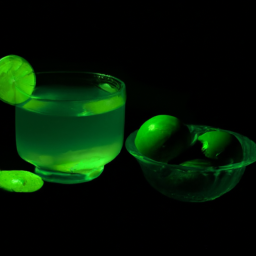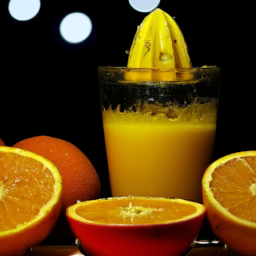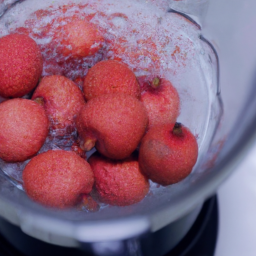When life gives you limes, the common saying recommends making lime juice. But how much juice can actually be squeezed from one lime?
As someone who loves to cook and experiment with new recipes, I’ve often found myself wondering how much juice I can get from a single lime, and how to maximize its yield. In this article, I’ll explore the science behind lime juice production, share tips for extracting the most juice from your limes, and provide insights into how to choose the best limes for juicing.
Lime juice is a key ingredient in many cuisines and cocktails, adding a tangy, acidic, and refreshing flavor to dishes and drinks. However, the amount of juice you can get from one lime can vary depending on several factors, including the size and ripeness of the lime, the extraction technique you use, and the storage conditions of the fruit.
By understanding these variables and following some simple guidelines, you can maximize the amount of juice you get from your limes and enhance the flavor and nutritional value of your recipes. Read on to learn more about the art and science of lime juice extraction.
Key Takeaways
- One lime yields about 2 tablespoons of juice.
- Lime size, ripeness, extraction technique, and storage conditions affect juice yield.
- Blending the entire fruit can maximize juice yield.
- Citrus substitutes may not have the same acidity level or flavor profile.
Understanding the Variability of Lime Juice Production
Hey, did you know that squeezing a lime can produce varying amounts of juice? The variability in lime juice yield is due to the fact that there are many factors that can influence how much juice a lime will produce.
For example, the ripeness of the lime, the juicing technique used, and the size of the lime can all impact the amount of juice that can be extracted. Lime juice extraction is not always a straightforward process, and it can be frustrating to try and extract juice from a lime that seems to be producing very little juice.
However, understanding the factors that affect lime juice yield variability is the first step towards being able to extract the most juice from each lime. Now, let’s dive into some techniques for extracting lime juice.
Techniques for Extracting Lime Juice
In my experience, there are three main techniques for extracting lime juice: manual juicing methods, using a citrus juicer, and maximizing juice yield with a blender.
Manual juicing methods involve squeezing the lime by hand or using a handheld juicer. Citrus juicers are machines specifically designed for juicing citrus fruits and can significantly reduce the time and effort needed to extract juice.
Finally, using a blender can help maximize juice yield by breaking down the lime pulp and releasing more juice.
Manual Juicing Methods
You can easily juice a lime by cutting it in half and using a handheld or electric citrus juicer to extract all of the juice. Handheld juicers are inexpensive and work well for small quantities of juice, but if you need to juice a large number of limes, an electric juicer may be a better option.
The benefits of adding sugar to lime juice include reducing the tartness and enhancing the flavor, as well as balancing the acidity and making the juice more palatable.
Using a citrus juicer is a convenient and efficient way to extract lime juice. It allows you to extract maximum juice with minimal effort. To use a citrus juicer, simply place half a lime cut-side down on the juicing cone and press down firmly. The juicer will extract the juice and separate it from the pulp and seeds.
Using a Citrus Juicer
Using a citrus juicer is an efficient way to extract the most juice from your limes. Compared to a hand juicer, a citrus press is a much better option as it can extract more juice with less effort. The press works by placing the halved lime in the press and then squeezing the handles to extract the juice.
This method not only saves time but also yields more juice. Electric juicers are also a popular option as they can extract even more juice in a shorter amount of time. These juicers work by spinning the fruit against a strainer, which separates the juice from the pulp.
While electric juicers may be more expensive than manual ones, they’re worth the investment if you plan on juicing frequently. With both manual and electric options, using a citrus juicer is a great way to ensure that you get the most out of your limes.
To maximize juice yield even further, using a blender is a great option. By blending the whole lime, including the peel and pulp, you can extract even more juice. With this method, there’s less waste and more juice yield.
Maximizing Juice Yield with a Blender
To get the most out of your limes, blend the entire fruit in a blender for maximum juice yield and less waste. Here’s how to do it:
- Adjust the blender speed: Start at a low speed and gradually increase to medium-high to extract the most juice without pulverizing the seeds and membranes, which can make the juice bitter.
- Choose ripe limes: Limes that are too hard or too soft will yield less juice than those that are firm but slightly yielding to the touch. A ripe lime also has a brighter color, a fragrant aroma, and a thinner skin that makes it easier to blend.
- Cut the lime into quarters: This makes it easier to fit in the blender and release the juice from the pulp.
- Strain the juice: Use a fine-mesh strainer or cheesecloth to remove any solids and pulp that might have escaped the blender.
By following these tips, you can extract up to 30% more juice from each lime, compared to hand-squeezing or using a citrus juicer.
This means you can save money, time, and effort, while enjoying the freshest and most flavorful lime juice for your cocktails, marinades, dressings, and desserts.
Now that you’ve maximized your lime juice yield, it’s time to measure it for your recipes. But how do you know how much juice one lime produces? Keep reading to find out.
Measuring Lime Juice for Recipes
If you’re whipping up a recipe that calls for lime juice, it’s important to know how much juice you can expect to get from a single lime. Measuring accuracy is key to ensure that your recipe turns out just right. On average, one lime yields about 2 tablespoons of juice. However, this can vary depending on the size and ripeness of the lime. It’s always best to have a few extra limes on hand just in case you need more juice than anticipated.
When it comes to measuring lime juice for recipes, it’s important to note that citrus substitutes may not have the same acidity level or flavor profile as lime juice. Therefore, it’s best to stick to the real thing for optimal results. Use a juicer or a hand-held citrus press to extract the juice from the lime. Once you have the desired amount, you can add it to your recipe and adjust as needed. Now that you know how much juice to expect from one lime, let’s move on to how to choose the best limes for juicing.
How to Choose the Best Limes for Juicing
When I’m looking to juice limes for a recipe, I always make sure to choose the best ones possible. To do this, I focus on two key points: identifying ripe limes and selecting the right size limes.
Ripe limes should feel heavy for their size and have a slightly soft skin, while the best size for juicing is typically medium to large. By following these tips, I ensure that my lime juice is flavorful and plentiful.
Identifying Ripe Limes
You can easily identify ripe limes by their vibrant green color, firmness, and fragrant aroma. Ripe lime characteristics include a bright green skin that is uniform in color, without any yellowing or blemishes. When you gently press the lime, it should feel firm and not too soft. An overripe lime will be squishy and have a dull appearance.
Ripeness testing methods for limes include the squeeze test and the weight test. To perform the squeeze test, gently press the lime with your fingers. If it gives slightly but still feels firm, it’s ripe and ready to use. If it feels too soft, it’s overripe. For the weight test, hold the lime in your hand and feel its weight. Ripe limes will feel heavy for their size, indicating that they’re full of juice.
Identifying and selecting ripe limes is important for getting the most juice out of each fruit. Factors affecting lime ripeness include weather conditions, growing location, and time of year. Once you’ve identified ripe limes, the next step is to select the right size limes for your recipe.
Selecting the Right Size Limes
Don’t miss out on the zesty punch of flavor in your recipe – grab the plump and juicy limes that are just the right size for your dish! When it comes to selecting limes for optimal juice production, size selection is key.
While larger limes might seem like a better deal, they may actually produce less juice than their smaller counterparts. This is because the amount of juice a lime can produce is largely determined by its ripeness.
To ensure maximum juice yield, it’s important to choose limes that meet specific ripeness standards. Look for limes that are firm, with a smooth skin and a vibrant green color. Avoid limes that are overly soft or have a yellowish hue, as these may be overripe and have already started to lose their juice content. Additionally, selecting limes that are slightly heavy for their size can also indicate that they are full of juice.
By paying attention to these size selection and ripeness standards, you can guarantee that your lime will yield the most juice possible.
When it comes to getting the most juice out of your limes, proper storage is also key. Keep reading to learn more about how to store limes for optimal juice production.
Storing Limes for Optimal Juice Production
To get the most juice out of your limes, it’s important to store them properly. Lime storage tips include preserving freshness by keeping them in a cool, dry place away from direct sunlight. If you want to extend their shelf life, you can also store limes in the refrigerator. Just make sure to take them out at least an hour before using them to allow them to come to room temperature, which can help improve the amount of juice you can extract.
Another important factor in storing limes is to avoid stacking them on top of each other or placing them in a plastic bag. This can cause them to become bruised or moldy, which can drastically reduce their juice yield. Instead, store them in a single layer in a breathable container such as a mesh produce bag or a basket.
By following these lime storage tips, you can ensure that you get the most juice out of your limes every time.
When it comes to the nutritional benefits of lime juice, there are plenty to talk about. Lime juice is a great source of vitamin C, which is important for boosting your immune system and reducing inflammation. It also contains antioxidants that can help protect your cells from damage and may even have cancer-fighting properties.
So not only can you enjoy the delicious taste of lime juice, but you can also reap the many health benefits it provides.
The Nutritional Benefits of Lime Juice
Sipping on a refreshing glass of lime juice not only satisfies your thirst, but it also provides your body with a burst of immune-boosting vitamin C and protective antioxidants. Lime juice is a great source of nutrients that support a healthy lifestyle.
Here are some of the health benefits and nutritional value of lime juice that you should know:
- Lime juice is high in vitamin C, which plays a vital role in strengthening the immune system and fighting off infections.
- Lime juice is low in calories and sugar, making it a great option for those who are watching their weight or blood sugar levels.
- Lime juice contains flavonoids and other antioxidants that can help protect your cells from damage and reduce the risk of chronic diseases such as cancer.
With these medical properties, lime juice is an excellent addition to any diet. However, it’s important to remember that while lime juice is a great source of nutrients, it’s not a substitute for a well-rounded diet.
Using lime juice in cooking and cocktails can add a zesty and tangy flavor to your favorite dishes and drinks.
Using Lime Juice in Cooking and Cocktails
Enhance the flavor of your favorite dishes and drinks with the zesty and tangy taste of lime juice. Lime juice is a versatile ingredient that can be used in a variety of recipes, from savory to sweet. It can be used as a marinade for meats, a dressing for salads, a flavor enhancer for soups, and even as an ingredient in cocktails.
Additionally, lime juice is known for its health benefits as it’s rich in vitamin C, antioxidants, and other nutrients that promote good health. When it comes to creative lime recipes, there are endless possibilities. Lime can be used to add a refreshing twist to classic recipes such as guacamole, salsa, and ceviche. It can also be used to create unique and exotic dishes such as lime and coconut curry or lime and ginger glazed salmon. For those with a sweet tooth, lime can be added to desserts such as key lime pie, lime and coconut cupcakes, and lime sorbet.
By incorporating lime juice into your cooking and baking, you can add a burst of flavor and nutrition to your meals and snacks. Transitioning into the subsequent section about common mistakes when juicing limes, it’s important to note that the amount of juice that one lime produces varies depending on the size and ripeness of the fruit. Therefore, it’s crucial to select limes that are plump and heavy and to use a citrus juicer to ensure maximum extraction.
Common Mistakes When Juicing Limes
As a culinary enthusiast, I love adding lime juice to my dishes and drinks. However, I’ve made some common mistakes when juicing limes, which led to a bitter taste in my recipes.
One of these mistakes is using a dull knife to cut the lime, which can damage the fruit’s cells, resulting in a sour and bitter flavor. Another mistake I made was squeezing the lime too hard, which caused the juice to mix with the bitter white pith, creating a rancid taste.
To avoid bitterness when juicing limes, I’ve learned to use a sharp knife to cut the fruit into halves or wedges. Then, I use a citrus juicer or a reamer to extract the juice without pressing too hard. Alternatively, I can use a fork to prick holes in the lime before microwaving it for 10-15 seconds, making it easier to extract the juice.
Another hack I use is to roll the lime on a hard surface before cutting it, which helps to break down the fibers and release more juice. By following these tips, I can get the most of my limes and enjoy their zesty flavor in my dishes and cocktails.
Moving on to the next section, here are some more tips and tricks for getting more juice from limes.
Tips and Tricks for Getting More Juice from Limes
Want to get the most out of your limes? Try these simple tricks for squeezing the most juice possible!
First, consider using alternative tools when juicing limes. While a traditional juicer or handheld citrus press can work well, a reamer or even a fork can be just as effective. Using a reamer involves cutting the lime in half and twisting it onto the reamer, which helps to release the juice. A fork can be used by piercing the lime and twisting it to release the juice. These alternative tools can help you get more juice out of your limes and make the process easier and more efficient.
Another important factor to consider when trying to get more juice from your limes is their acidity levels. Limes that are too ripe or not ripe enough may not produce as much juice. It’s best to choose limes that are firm and have a bright green color.
Additionally, warming up the limes before juicing can help to release more juice. To do this, microwave the limes for 10-15 seconds or roll them on the counter before cutting them open.
By following these simple tips and tricks, you can get the most juice possible from your limes and elevate the flavor of your dishes and drinks.
Frequently Asked Questions
Can lime juice be frozen for later use?
Yes, lime juice can be frozen to preserve its flavor. To do so, squeeze the juice and pour it into an ice cube tray. Once frozen, transfer the cubes to a freezer bag. Thaw as needed for future use.
Are there any health risks associated with consuming too much lime juice?
Consuming excessive lime juice can lead to acid reflux and tooth decay. However, moderate consumption can provide potential health benefits such as improved digestion and immunity. The recommended daily intake is one lime’s worth of juice.
How long does it take for limes to go bad and lose their juice production capacity?
I researched the shelf life of lime juice and found that it can last up to 2 weeks when properly stored. To preserve lime juice, keep it in an airtight container in the fridge and avoid exposing it to sunlight.
Can lime juice be used as a substitute for lemon juice in recipes?
When substituting lime for lemon juice in a recipe, keep in mind that lime has a distinct flavor. Lime is a better choice for cocktails, but choose limes that are heavy for their size and have smooth, shiny skin for optimal juicing.
What are some alternative methods for extracting lime juice besides using a juicer or hand-squeezing?
There are alternative methods for lime juice extraction, such as citrus zesting to add lime zest to recipes or lime oil extraction for use in cooking. These methods can add unique flavors and aromas to dishes.
Conclusion
In conclusion, understanding the variability of lime juice production is essential for any aspiring chef or mixologist. Did you know that on average, one lime produces about 1 to 2 tablespoons of juice? However, this can vary depending on factors such as the ripeness of the lime, the juicing technique used, and even the individual lime itself.
By using the techniques and tips outlined in this article, you can maximize your lime juice yield and create delicious dishes and cocktails. From choosing the best limes for juicing to storing them properly, every step of the process can affect the amount of juice you get.
So, next time you reach for a lime, remember that a little knowledge can go a long way in getting the most out of this versatile citrus fruit.
Ilana has been a vegan for over 10 years. She originally made the switch for health reasons, but soon found herself becoming more and more passionate about the ethical and environmental implications of a vegan lifestyle. Ilana is the author of The Graceful Kitchen, a blog all about veganism. She loves to cook up delicious and nutritious vegan meals, and share her recipes with others who are interested in leading a cruelty-free life. Ilana is also a strong advocate for using whole foods as the foundation of a healthy diet, and believes that going vegan is one of the best ways to achieve this.










